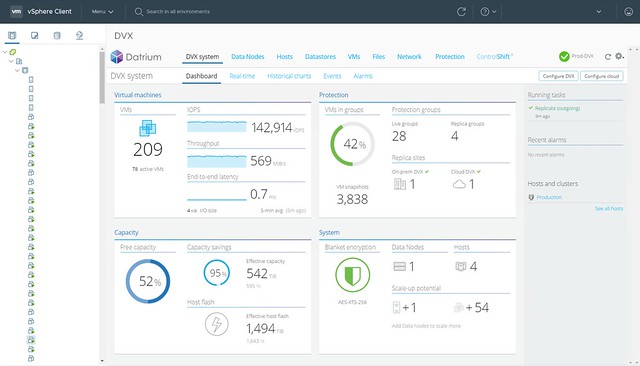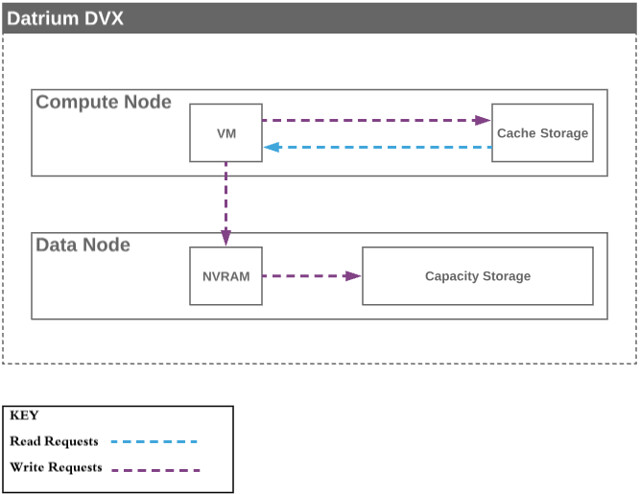Posted by Simon Long Jul 26, 2018
What is Datrium DVX?
Having recently joined Datrium, one of my first tasks is to begin to understand the product Datrium calls DVX. As a way of helping me wrap my head around this technology, I’ve decided to blog about it. I plan on starting at a high-level and then slowly digging deeper under the covers as I learn more.
If you are interested in following my posts, you can subscribe here and follow me on Twitter.
So to begin with, let’s start at the 100 level.
What is Datrium DVX? – 100 Level
Datrium DVX offers Disaggregated Hyper-Converged Infrastructure (DHCI) along with Cloud Mobility. Yep, lots of buzzwords there! So what does that actually mean? Let’s start with the basic question, “What is the Datrium DVX solution made up of?”

A Datrium DVX is made up of at least two components:
Compute Nodes (Hosts)
Compute Nodes are x86 servers that contain CPU/MEM/NVME or SSD storage and network interfaces. These servers can either be purchased from a Datrium partner as a pre-configured server, or customers can buy/use their own servers (Compute Node hardware requirements). Typically, these Compute Nodes are running the VMware ESXi Hypervisor. However, they can also be running RedHat KVM or a LinuxOS (Bare-metal). As the majority of my readers are VMware customers, I’m going to focus a little more on the ESXi implementation.
On the ESXi Hosts (Compute Nodes), DVX installs a vSphere Installation Bundle (VIB) which Datrium calls the Hyperdriver. The Hyperdriver is the brains of the solution.
Data Nodes
Data Nodes are physical hardware appliances that are purchased through Datrium. Each Data Node contains dual active/standby controllers with redundant NVRAM, 2 x 10 Gbps (or 2 x 25Gbps for all Flash) network interfaces, and at least 12 storage devices, HDD or SSD (More details here).
How Does It Work?
Now we know that DVX is made up of at least one Compute Node and one Data Node (I’ll cover scaling in a future post), let’s talk about how it all works together at VERY high-level.
During the DVX configuration, the Compute Node needs to be registered to the Data Node. The first part of the registration is the automatic installation of the Hyperdriver onto the Compute Node allowing both the Data and Compute Nodes to communicate back and forth. The second part configures the local SSD and/or Flash devices on the Compute Node to be used for the ‘local cache’ tier of storage. This new ‘local cache’ tier is then automatically presented to ESXi as a Datastore.
An optional step in the configuration is to register the Data Node with your vCenter/s. This puts vCenter and DVX into a single pane of glass, allowing centralized monitoring and management via the vSphere client (both Web or HTML clients). See the image below as an example.

This is how:

When a running VM requires information from its virtual machine files stored on the DVX Datastore (read request), it will read the data directly from the devices that are installed on that Compute Node. When that running VM needs to write information to the virtual machine files stored on the DVX Datastore (write request), it will simultaneously write that data onto both the devices that are installed on the Compute Node AND the devices that are installed on Data Node.
This is done to provide the following:
Amazing Read Performance (Think – “Fast”)
By having all read requested serviced from the local storage within the Compute Nodes, DVX can ensure that the applications running on the VMs get amazing storage performance.
Data Protection & Persistence (Think – “Safe”)
By writing all write requests to both the Computer Node and the Data Node, DVX can provide persistence and resiliency by storing a protection copy of all of the VMs running on the Compute Node. In addition to this, data is also protected with Erasure Coding, providing resiliency for any 2 simultaneous disk failures. (More in this in a later post)
But wait there’s more!
A lot more in fact! We haven’t touched on deduplication and compression which is ALWAYS ON, end-to-end data encryption, or protection group snapshot replication into the Public Cloud for off-site backup, or….. I think you get my point.
A couple of my colleagues here at Datrium @storageidealist & @clintwyckoff recorded a really cool lightboard session talking about the basics of DVX. It’s really worth a watch. If you enjoy the video and want to see more and maybe even some content from myself, be sure to subscribe to the Datrium YouTube channel.
